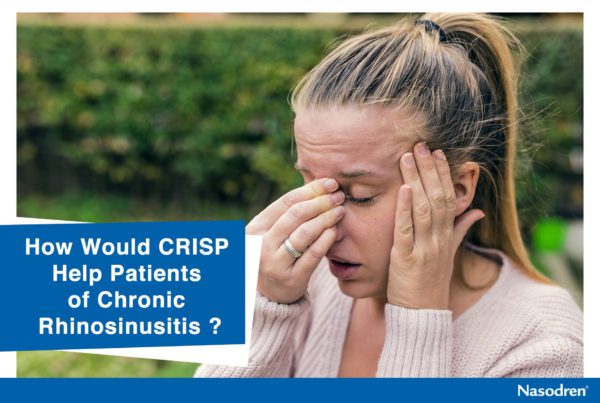Nasodren Prescribing information
1.NAME OF THE PRODUCT: NASODREN, Powder for the preparation of a nasal spray. 2.QUALITATIVE AND QUANTITATIVE COMPOSITION: Ingredient: Lyophilized powder from the juice and the natural aqueous extract from fresh tubers of Cyclamen europaeum L., 50 mg. The powder is porous, hygroscopic and cream-coloured. Excipients: No excipients, no preservatives or chlorides. Purified water 5 ml, as solvent for reconstitution of the lyophilized powder. Each dose of nasal spray releases 0.13 ml (2-3 drops) of solution (pH 5.3-6.8). This quantity corresponds to 1.3 mg powder. The finished solution produces 38 doses to be applied for a maximum of 16 days.
3.CLINICAL PARTICULARS: 3.1 Therapeutic indications: NASODREN is indicated for the symptomatic relief and treatment of diseases of nasal and paranasal cavities, and of the middle ear: Acute or chronic recurrent inflammation of the paranasal sinuses (rhinosinusitis): catarrhal or purulent maxillary rhinosinusitis, frontitis, ethmoiditis, sphenoiditis, or combined rhinosinusitis. Acute purulent rhinosinusitis, accompanied by generalized infection or orbital complications. In case of orbital complications or generalized infection, NASODREN should be administered in combination with antibiotics. Acute exudative or purulent otitis media, chronic exudative, Acute secretory otitis media or purulent otitis media. In case of fever, NASODREN should be administered in combination with antibiotics. In postoperative care, after nasal or sinonasal surgery. 3.2 Posology and method of administration: Posology in adults and children 5 years and above:
The solution is sprayed daily only once into each nostril, preferably at the same time of day, approximately 2 hours before bedtime.
Increasing the daily dose does not result in an increased effect. The treatment normally lasts 7-10 days when being used daily but may be extended to 12-16 days if necessary. A significant improvement or total symptomatic relief is achieved after 6-8 applications; however, headaches often associated with the condition may reduce or stop completely after only 3-5 applications of NASODREN. Nevertheless, treatment should be continued for the recommended duration of 7-10 days. In cases which are complicated by purulent infection, concurrent systemic antibiotic treatment is recommended. If a second treatment is necessary in severe or chronic cases, this should only be initiated 7-10 days after completion of the previous course. If a dose of the treatment is forgotten, the patient should continue with the treatment the next day as recommended. 3.3 Contraindications: Individual hypersensitivity against Cyclamen, Primula and other Primulaceae.
Polyposis of the nose and the paranasal sinuses that can block the meatus and secretion. 3.4 Special warnings and special precautionsof use: Apply only one spray per day into each nostril. Avoid inhaling during application. Avoid eye contact. Contact of the Product with the eyes may result in irritation and symptoms of Acute conjunctivitis.
Take note of the section 3.5 Interaction with other Products and other forms of interaction. If necessary, other nasal Products can be administered 1.5-2h before or after NASODREN. Undesirable effects are related to the specific mechanism of action, and may include some itching, sneezing, a brief sensation of mild to moderate burning in the nasopharynx, reflex salivation and, more rarely, a brief lacrimation and flushing of the face (especially in patients treated with antihypertensive medication). However, these are manifestations of the positive response to the Product. When prescribing NASODREN, it is suggested that the physician explains these effects to the patients as being due to the stimulation of N. trigeminus and N. facialis. All these effects usually diminish during the course of treatment. In some isolated cases a mild temporary headache or pale pink discharge may appear. It is not necessary to stop treatment in these cases. Accidental use by patients allergic to Cyclamen, Primula and other Primulaceae, which could lead to swelling of the nasal mucosa, eyelids and/or face. 3.5 Interaction with other Products and other forms of interactions:
Simultaneously administered parasypa- thomimetic drugs acting either directly (e.g. carbachol, pilocarpine, betanechol), or indirectly (cholinesterase inhibitors like neostigmine, ambenonium etc) will potentiate the effect of NASODREN (due to amplification of released acetylcholine action in the respective synapses). After application of NASODREN, a slight issuing of red blood cells in the nose was observed in some patients. Therefore, treatment with anticoagulants(e.g. coumarin derivatives, acetylsalicylic acid) should be suspended and the application of NASODREN commenced, taking into account the rate of elimination of the particular anticoagulant. 3.6 Pregnancy and lactation: There is no experience regarding the administration of NASODREN during pregnancy and breast-feeding in humans. Therefore, NASODREN should not be administered during pregnancy and breastfeeding, especially during the first trimester. 3.7 Effects on ability to drive or to operate machinery: Driving or operating machinery is not recommended for 2 hours after using the spray. 3.8 Adverse Reactions: In very rare cases of prolonged lacrimation or salivation lasting more than 2 hours, give atropine or other anticholinergics such as scopolamine to stop the secretory response. 3.9 Overdose: Exceeding the required dose may cause a severe burning sensation in the nasal mucosa or nasopharynx, without serious consequences. In case of an accidental overdose irrigation of the nasal cavity through the nostrils with warm water, and pharyngeal gargling with warm water can be useful. 4. PRODUCT PROPERTIES: 4.1 Incompatibilities: NASODREN is incompatible with anticholinergics (such as atropine, tropicamide etc.). Date of revision: September 2010.







